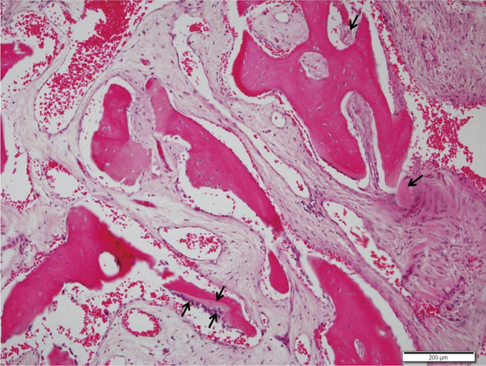J Adv Prosthodont.
2013 May;5(2):167-171. 10.4047/jap.2013.5.2.167.
Guided bone regeneration using demineralized allogenic bone matrix with calcium sulfate: case series
- Affiliations
-
- 1Department of Oral and Maxillofacial Surgery, Section of Dentistry, Seoul National University Bundang Hospital, Seongnam, Republic of Korea.
- 2Department of Oral and Maxillofacial Surgery, School of Dentistry, Chosun University, Gwangju, Republic of Korea. sgckim@chosun.ac.kr
- 3Department of Pathology, School of Medicine, Chosun University, Gwangju, Republic of Korea.
- KMID: 2284757
- DOI: http://doi.org/10.4047/jap.2013.5.2.167
Abstract
- PURPOSE
The purpose of this case series was to evaluate the effect of guided bone regeneration using demineralized allogenic bone matrix with calcium sulfate.
MATERIALS AND METHODS
Guided bone regeneration using Demineralized Allogenic Bone Matrix with Calcium Sulfate (AlloMatrix(TM), Wright. USA) was performed at the time of implant placement from February 2010 to April 2010. At the time of the second surgery, clinical evaluation of bone healing and histologic evaluation were performed. The study included 10 patients, and 23 implants were placed. The extent of bony defects around implants was determined by measuring the horizontal and vertical bone defects using a periodontal probe from the mesial, distal, buccal, and lingual sides and calculating the mean and standard deviation of these measurements. Wedge-shaped tissue samples were obtained from 3 patients and histologic examination was performed.
RESULTS
In clinical evaluation, it was observed that horizontal bone defects were completely healed with new bones, and in the vertical bone defect area, 15.1% of the original defect area remained. In 3 patients, histological tests were performed, and 16.7-41.7% new bone formation was confirmed. Bone graft materials slowly underwent resorption over time.
CONCLUSION
AlloMatrix(TM) is an allograft material that can be readily manipulated. It does not require the use of barrier membranes, and good bone regeneration can be achieved with time.
Keyword
MeSH Terms
Figure
Reference
-
1. Urist MR, Strates BS. Bone morphogenetic protein. J Dent Res. 1971; 50:1392–1406.2. Han B, Tang B, Nimni ME. Quantitative and sensitive in vitro assay for osteoinductive activity of demineralized bone matrix. J Orthop Res. 2003; 21:648–654.3. Schwartz Z, Mellonig JT, Carnes DL Jr, de la Fontaine J, Cochran DL, Dean DD, Boyan BD. Ability of commercial demineralized freeze-dried bone allograft to induce new bone formation. J Periodontol. 1996; 67:918–926.4. Takikawa S, Bauer TW, Kambic H, Togawa D. Comparative evaluation of the osteoinductivity of two formulations of human demineralized bone matrix. J Biomed Mater Res A. 2003; 65:37–42.5. Ziran B, Cheung S, Smith W, Westerheide K. Comparative efficacy of 2 different demineralized bone matrix allografts in treating long-bone nonunions in heavy tobacco smokers. Am J Orthop (Belle Mead NJ). 2005; 34:329–332.6. Traianedes K, Russell JL, Edwards JT, Stubbs HA, Shanahan IR, Knaack D. Donor age and gender effects on osteoinductivity of demineralized bone matrix. J Biomed Mater Res B Appl Biomater. 2004; 70:21–29.7. Zhang M, Powers RM Jr, Wolfinbarger L Jr. A quantitative assessment of osteoinductivity of human demineralized bone matrix. J Periodontol. 1997; 68:1076–1084.8. Kim YK, Kim SG, Lee BG. Bone Graft and Implant. Bone biology and bone graft material. Vol. 1. Seoul, Korea: Daehan Narae Pub Co;2007. p. 140–142.9. Wilkins RM, Kelly CM, Giusti DE. Bioassayed demineralized bone matrix and calcium sulfate: use in bone-grafting procedures. Ann Chir Gynaecol. 1999; 88:180–185.10. Adkisson HD, Strauss-Schoenberger J, Gillis M, Wilkins R, Jackson M, Hruska KA. Rapid quantitative bioassay of osteoinduction. J Orthop Res. 2000; 18:503–511.11. Cheung S, Westerheide K, Ziran B. Efficacy of contained metaphyseal and periarticular defects treated with two different demineralized bone matrix allografts. Int Orthop. 2003; 27:56–59.12. Gitelis S, Piasecki P, Turner T, Haggard W, Charters J, Urban R. Use of a calcium sulfate-based bone graft substitute for benign bone lesions. Orthopedics. 2001; 24:162–166.13. Turner TM, Urban RM, Gitelis S, Kuo KN, Andersson GB. Radiographic and histologic assessment of calcium sulfate in experimental animal models and clinical use as a resorbable bone-graft substitute, a bone-graft expander, and a method for local antibiotic delivery. One institution's experience. J Bone Joint Surg Am. 2001; 83-A:8–18.14. Kelly CM, Wilkins RM, Gitelis S, Hartjen C, Watson JT, Kim PT. The use of a surgical grade calcium sulfate as a bone graft substitute: results of a multicenter trial. Clin Orthop Relat Res. 2001; 382:42–50.15. Carpenter JF, Pikal MJ, Chang BS, Randolph TW. Rational design of stable lyophilized protein formulations: some practical advice. Pharm Res. 1997; 14:969–975.
- Full Text Links
- Actions
-
Cited
- CITED
-
- Close
- Share
- Similar articles
-
- Guided Bone Regeneration Using a Putty-type Demineralized Bone Matrix: Case Report
- A Comparative Study on Regeneration of Bone Defects after the Grafts of Demineralized Bone Matrix and Hydroxyapatite
- An experimental study on the effect of calcium sulfate on bone regeneration
- Demineralized allogenic and heterogenic bone matrix for repair of segmental bone defect in rabbits
- BONE REGENERATION IN COMPOSITE GRAFT OF FREEZE-DRIEDDEMINERALIZED BONE AND HYDROXYLAPATITE IN RABBIT CRANIAL DEFECTS




